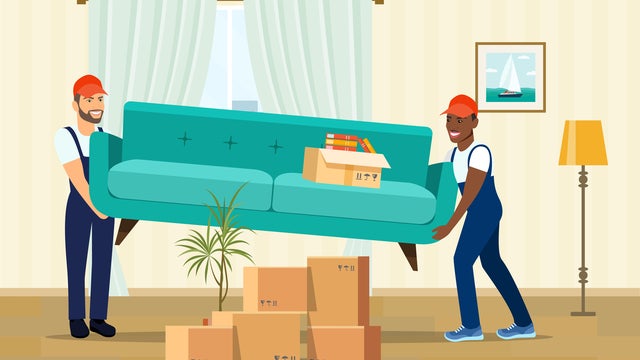Our 10 Step Moving Checklist covers:
Before you begin packing, it’s a good idea to take stock of your belongings, to see where you can cut back. Often, you may find the same box is moved from house to house without being totally unpacked. If you haven’t used an object in the last few years, do you really need to save it?
Also, you could try to start packing your non day-to-day items earlier, to reduce the workload closer to your move date. To help get you started when planning your move, Canstar has devised a simple checklist of some of the essentials:
1. Do you need a removalist service?
When moving, you generally have two choices: moving your belongings yourself (perhaps with the help of friends or family), or finding a professional removalist. If you would rather hire a removalist service, word-of-mouth can be an effective way to find one that has a good track record in your area.
Also check reviews online. Most professional removalists offer different levels of support, from packing and unpacking everything, through to simply loading up your pre-packed boxes and furniture.
2. Collect packing boxes
Are you packing your household items yourself? If so, you’ll need a supply of good-quality moving boxes and strong packing tape. Many removalists and storage facilities sell boxes, or you could ask for old cardboard boxes at your local supermarket.
3. Consolidate and pack
When you begin to pack, you may rediscover belongings you have long forgotten about. Think about whether you need to organise a skip bin to dispose of rubbish, arrange a garage sale for any sellable (but unwanted) items, or donate any unwanted items to charity.
When packing, make sure you use adequate padding for your fragile items. And double-check the weight limits of the boxes you are using. For example, don’t pack a large box full of books, as it will become too heavy to lift.
Also, clearly marking which room a box is intended for can speed up the unpacking process at the other end.
4. Take care of outstanding bills
Double-check if you have any outstanding rates or utility bills. If you can, it’s a good idea to pay them off before you move, and let your provider know you are moving. This will reduce the risk of losing paperwork or accidentally accruing late fees.
5. Disconnect and connect utilities
When you know your move-out date, you can arrange for your utilities to be disconnected at the house you are moving out of, and connected ready for your arrival at your new house. These include:
- Landline/broadband
- Gas
- Electricity
- Water
Sometimes, utility providers will require access to your new house, which may mean a delay in getting connected, so it could be worth ensuring you have a contingency plan in place. There’s plenty of advice on Canstar Blue on choosing the best electricity and broadband providers.
6. Arrange cleaning
When it comes to cleaning a rental property, you have two choices:
- Doing it yourself
- Hiring professional cleaners.
Many cleaners specialise in helping people who are moving house. And for renters, they often guarantee their work to a standard that warrants full bond repayment. Of course, hiring a pro-cleaner is more expensive than the DIY option.
7. Consider insurance
Whether you are home owner or renting, it’s always a good idea to organise insurance to protect your belongings in your new home.
You can also ask your provider about cover during your move, just in case anything doesn’t arrive at the new property in its original condition. Transit insurance can help provide a level of financial cover for your possessions if they are damaged and/or lost while they are in transit to your new home.
→ Related article: Transit Insurance When Moving House: Do You Need It?

Compare home and contents insurance providers
8. Update your address details
Ensure you advise all your service providers of your new address, so your contact details are up to date. These include:
- Banks and any other financial institutions
- Tax and legal advisors
- Medical & dental practitioners
- Electoral Commission
- Clubs, associations and other groups
- Schools
- Any subscription services (e.g. magazines)
- Road authority
- Any online shopping websites you use, for example Amazon, Trade Me, Book Depository
9. Redirect your mail
Even if you are sure you have proactively updated your address with all your providers, it’s surprising how much mail could still be sent to you at your previous home. By redirecting your mail for three months, you can see if there are any companies or friends and family who missed the memo. You can apply to redirect your mail on the New Zealand Post website.
10. Cancel any other regular deliveries
Do you have a newspaper delivered? How about groceries? Ensure you cancel any regular deliveries. Also remember to cancel any other household services you may use, such as a gardener or widow cleaner.
Want to save money on your mortgage? Canstar can help
One of the easiest ways to reduce the cost of buying a home is to ensure that you secure the lowest mortgage rate. And this is something Canstar can help you with. Our mortgage comparison tools are free, easy to use and can help you find the best rates. And our product ratings are never influenced by any commercial relationships that we have.
The table below displays some of the 1-year fixed-rate home loans on our database (some may have links to lenders’ websites) that are available for home owners looking to refinance. This table is sorted by current interest rates (lowest to highest), followed by company name (alphabetical). Products shown are principal and interest home loans available for a loan amount of $500K in Auckland. Before committing to a particular home loan product, check upfront with your lender and read the applicable loan documentation to confirm whether the terms of the loan meet your needs and repayment capacity. Use Canstar’s home loan selector to view a wider range of home loan products. Canstar may earn a fee for referrals.
Compare Lowest Home Loan Rates for Refinancing
About the author of this page
 This report was written by Canstar’s Editor, Bruce Pitchers. Bruce began his career writing about pop culture, and spent a decade in sports journalism. More recently, he’s applied his editing and writing skills to the world of finance and property. Prior to Canstar, he worked as a freelancer, including for The Australian Financial Review, the NZ Financial Markets Authority, and for real estate companies on both sides of the Tasman.
This report was written by Canstar’s Editor, Bruce Pitchers. Bruce began his career writing about pop culture, and spent a decade in sports journalism. More recently, he’s applied his editing and writing skills to the world of finance and property. Prior to Canstar, he worked as a freelancer, including for The Australian Financial Review, the NZ Financial Markets Authority, and for real estate companies on both sides of the Tasman.
Enjoy reading this article?
You can like us on Facebook and get social, or sign up to receive more news like this straight to your inbox.
By subscribing you agree to the Canstar Privacy Policy
Enjoy reading this article?
You can like us on Facebook and get social, or sign up to receive more news like this straight to your inbox.
By subscribing you agree to the Canstar Privacy Policy







Share this article